- Scientific name: Myriophyllum alterniflorum
- Species of Greatest Conservation Need (MA State Wildlife Action Plan)
- Endangered (MA Endangered Species Act)
Description
Slender water-milfoil is a delicate, aquatic herb in the water-milfoil family (Haloragaceae). It has slender, elongated stems, and is rooted to the substrate submersed in shallow water. Its leaves are delicate, feather-like, and arranged in whorls of three to five along the stem. The tips of stems are emergent and form slender terminal inflorescences. These erect spikes have greatly reduced leaves (bracts), with minute, inconspicuous flowers in the axils. Fruits are small (1.5-2 mm; 0.1 in), nut-like, and split into four one-seeded segments that are rounded and granular on the back.
The identification of water-milfoils (Myriophyllum spp.) is difficult and requires careful examination of foliage, flower arrangement, floral bracts, and fruits. Slender water-milfoil is identified by its short (3-12 mm; 0.1-0.5 in)leaves dissected into three to seven pairs of segments, short internodes (mostly < 1 cm; 0.4 in), short spikes (2-5 cm tall; 0.8-2 in), and an alternate arrangement of at least the uppermost floral bracts and flowers. The lowermost bracts and flowers may be opposite. The floral bracts have entire or minutely-toothed margins and are shorter or equal in length to the flowers. This species does not form winter buds (turions).
Slender water-milfoil resembles other, more common water-milfoils. It can be distinguished from lowly water-milfoil (M. humile) by its distinctly whorled foliage, emergent spikes, and short bracts. Lowly water-milfoil has alternate leaves and spikes in the axils of submerged leaves or, if emergent, bracts that are longer than the flowers. Slender water-milfoil can be distinguished from other water-milfoil species with whorled leaves, like variable water-milfoil (M. heterophyllum), northern water-milfoil (M. sibiricum), and whorled water-milfoil (M. verticillatum), by its smaller leaves with fewer segments, shorter spikes, and alternate arrangement of bracts and flowers. Northern water-milfoil and whorled water-milfoil can also be separated by the presence of axillary winter buds late in the growing season.
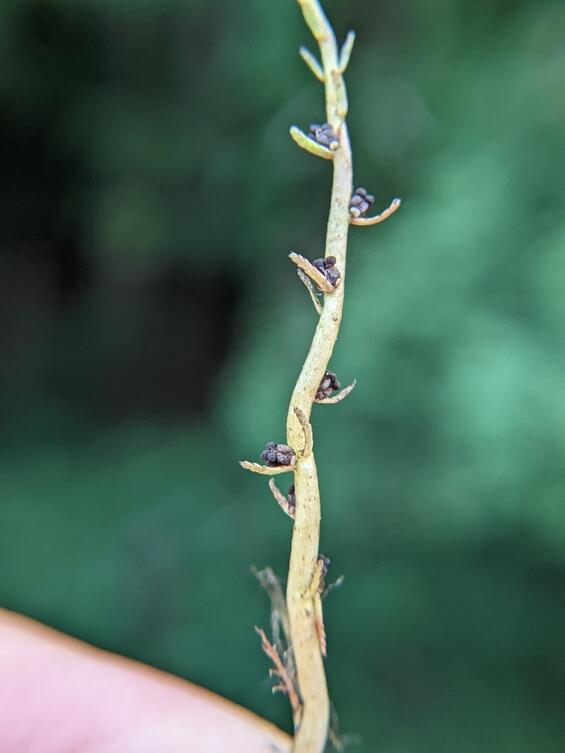
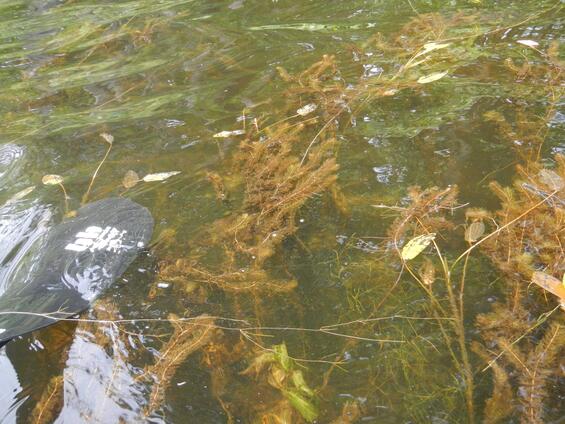
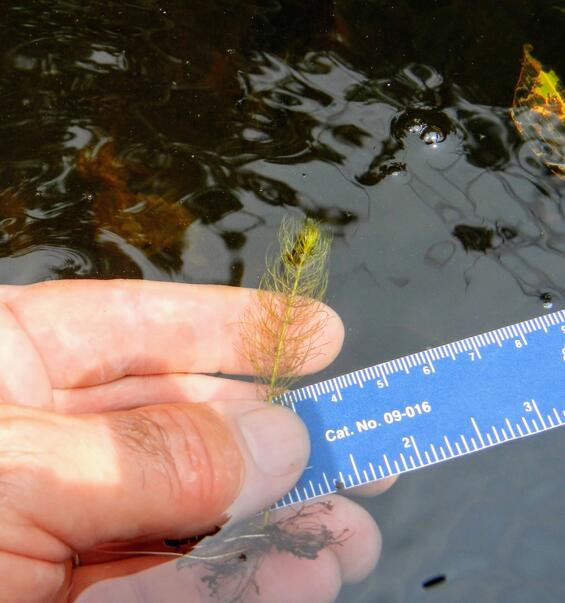
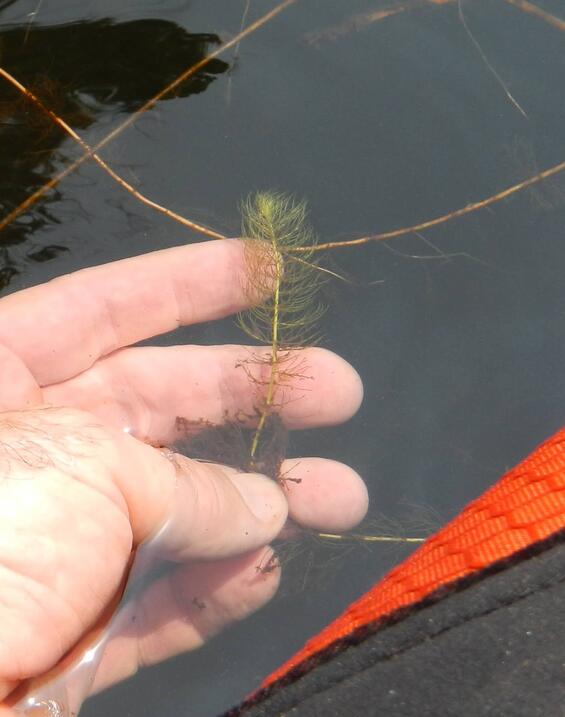
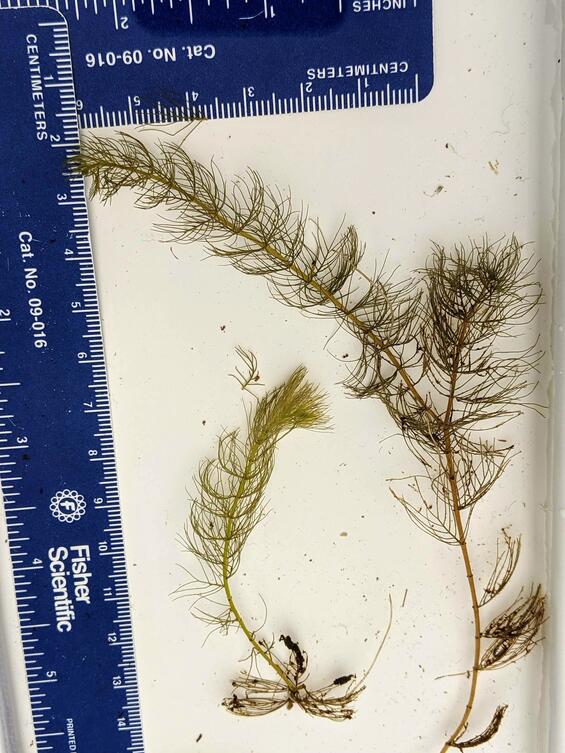
Life cycle and behavior
This is an aquatic plant that flowers in mid to late summer.

Population status
Slender water-milfoil is listed under the Massachusetts Endangered Species Act as endangered. All listed species are protected from killing, collecting, possessing, or sale, and from activities that would destroy habitat and thus directly or indirectly cause mortality or disrupt critical behaviors. The Massachusetts Natural Heritage & Endangered Species Program has 7 records from 4 counties: Essex, Norfolk, Suffolk, and Worcester. Two of these records have been observed within the last 25 years.
Distribution and abundance
Slender water-milfoil occurs in both North America and Europe. In North America, it occurs from Greenland to Newfoundland, west to Ontario and Minnesota, and south to Massachusetts and New York.
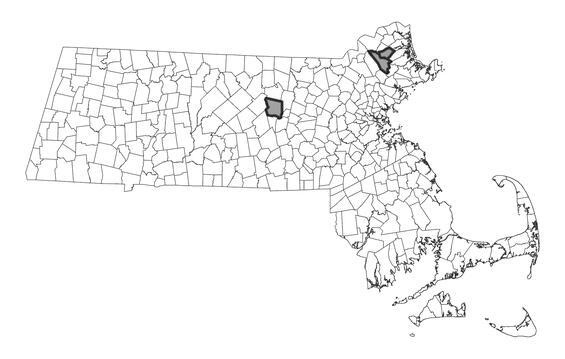
Distribution in Massachusetts. 1999-2024. Based on records in the Natural Heritage Database.
Habitat
Slender water-milfoil occurs in shallow waters of lakes, ponds, and slow streams. Plants found in association with slender water-milfoil include great bladderwort (Utricularia macrorhiza), purple bladderwort (U. purpurea), flat-leaved bladderwort (U. intermedia), tiny pondweed (Potamogeton pusillus), ribbon-leaf pondweed (P. epihydrus), robbins pondweed (P. robbinsii), perfoliate pondweed (P. perfoliatus), Vasey’s pondweed (P. vaseyi), water-marigold (Bidens beckii), Nuttall’s water-weed (Elodea nuttallii), tape-grass (Vallisneria americana), pipewort (Eriocaulon aquaticum), bayonet-rush (Juncus militaris), floating heart (Nymphoides cordata), grass-leaf arrowhead (Sagittaria graminea), and fanwort (Cabomba caroliniana).
Healthy habitats are vital for supporting native wildlife and plants. Explore habitats and learn about conservation and restoration in Massachusetts.
Threats
As for many rare species, exact needs for management of slender water-milfoil are not known. Because this species grows submersed in open water, any alteration of hydrological conditions, water quality, or erosion and sedimentation rates could impact extant populations. Competition from invasive aquatic species may also reduce the available habitat of slender water-milfoil. Mechanical or non-specific chemical controls of invasive species may also threaten populations. This being a species limited to northern distribution, climate warming is a potential threat. The past 130 years have seen a warming of 1.4 degrees C, (2.5 degrees F) in the Northeast United States (Staudinger et al. 2024). Northern species can be expected to move much further north in an attempt to occupy a habitat within their evolved climate envelope. All active management of rare plant populations (including invasive species removal) is subject to review under the Massachusetts Endangered Species Act and should be planned in close consultation with the MassWildlife’s Natural Heritage & Endangered Species Program.
Conservation
Survey and monitoring
As there are only two populations currently known in Massachusetts, and considering that a boat is required, is it very likely this species is under-surveyed. Surveys both of past known locations and new potential sites are needed. The best time to survey for it is when it is in fruit from early July through very early August.
Management
The ecological needs of this species are not well understood, so management needs are not well known. However, controlling invasive aquatic species may be needed, as might maintenance or restoration of hydrology. Hand-pulling of aquatic invasive species is recommended around populations of rare aquatic species. This can include pulling done with SCUBA gear which has shown to be effective in some situations.
All active management of rare plant populations (including invasive species removal) is subject to review under the Massachusetts Endangered Species Act and should be planned in close consultation with the MassWildlife’s Natural Heritage & Endangered Species Program.
Research needs
The exact ecological needs of this species are not well understood. As this plant is under-surveyed, standard information is needed such as lists of associated species, comments on water and habitat quality and threats, and assessments of soil conditions and phenology. Research is needed to determine whether this plant can be grown in an aquarium or small pool in a greenhouse or garden setting for purposes of reintroductions. If habitat degradation accelerates losses of current populations, this strategy could prove useful to long-term conservation of this species.
References
Aiken, S.G. 1981. A conspectus of Myriophyllum (Haloragaceae) in North America. Brittonia 33: 57-69.
Crow, G.E., and C.B. Hellquist. 1983. Aquatic Vascular Plants of New England: Part 6. Trapaceae, Haloragaceae, Hippuridaceae. New Hampshire Agricultural Experiment Station. University of New Hampshire Station Bull. 524, Durham, NH.
Staudinger, M.D., A.V. Karmalkar, K. Terwilliger, K. Burgio, A. Lubeck, H. Higgins, T. Rice, T.L. Morelli, A. D'Amato. 2024. A regional synthesis of climate data to inform the 2025 State Wildlife Action Plans in the Northeast U.S. DOI Northeast Climate Adaptation Science Center Cooperator Report. 406 p. https://doi.org/10.21429/t352-9q86
Contact
| Date published: | May 8, 2025 |
|---|